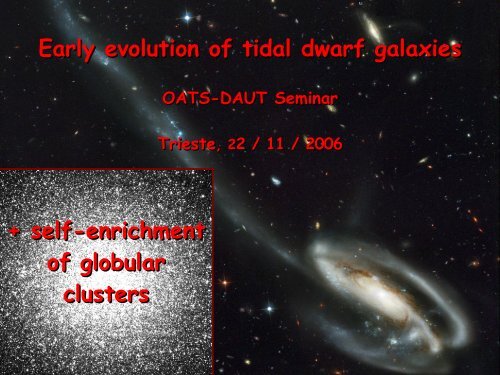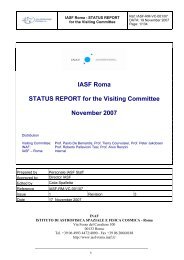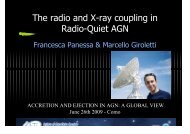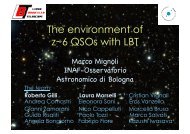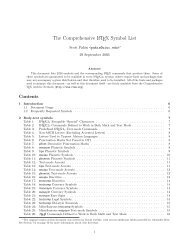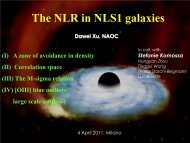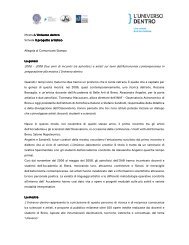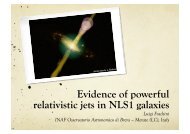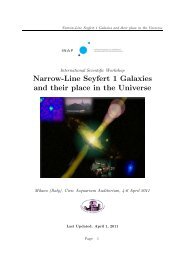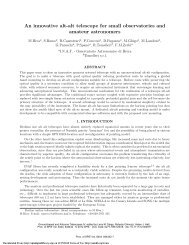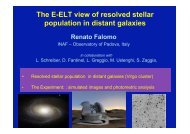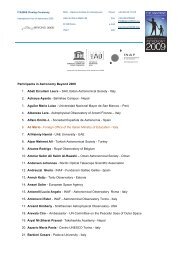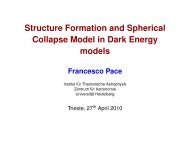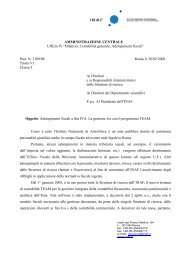Early evolution of tidal dwarf galaxies - INAF-OAT Trieste Users site
Early evolution of tidal dwarf galaxies - INAF-OAT Trieste Users site
Early evolution of tidal dwarf galaxies - INAF-OAT Trieste Users site
Create successful ePaper yourself
Turn your PDF publications into a flip-book with our unique Google optimized e-Paper software.
<strong>Early</strong> <strong>evolution</strong> <strong>of</strong> <strong>tidal</strong> <strong>dwarf</strong> <strong>galaxies</strong><br />
<strong>OAT</strong>S-DAUT Seminar<br />
<strong>Trieste</strong>, , 222<br />
2 / 11 / 2006<br />
+ self-enrichment<br />
<strong>of</strong> globular<br />
clusters
PART I:<br />
<strong>Early</strong> <strong>evolution</strong> <strong>of</strong> <strong>tidal</strong> <strong>dwarf</strong> <strong>galaxies</strong><br />
Pavel Kroupa (Bonn)<br />
Christian Theis, Gerhard Hensler, Andrea Marcolini (Vienna)<br />
Francesca Matteucci (DAUT-<strong>Trieste</strong>)
PART I:<br />
<strong>Early</strong> <strong>evolution</strong> <strong>of</strong> <strong>tidal</strong> <strong>dwarf</strong> <strong>galaxies</strong><br />
outline:<br />
The astrophysical context<br />
Investigation method<br />
Preliminary results
The hierarchical buildup <strong>of</strong> a Milky Way halo<br />
(from Ben Moore's web<br />
<strong>site</strong> www.nbody.net)
The “missing satellites” problem<br />
Ben Moore web <strong>site</strong> Grebel (2000)
The “missing satellites” problem<br />
Moore et al. (1999)
The “missing satellites” problem<br />
possible solutions<br />
●<br />
Gas is held/captured only by the 11 most massive CDM subhalos<br />
(Stoehr et al. 2002)<br />
●<br />
Ionization from UV radiation prevents gas accretion in most<br />
<strong>of</strong> the DM halos (Gnedin 2000) and/or can photoevaporate gas<br />
(Shaviv & Dekel 2003)<br />
●<br />
Tidal interactions reduce drastically the masses and the<br />
circular velocities <strong>of</strong> sub-halos (Kravtsov et al. 2004)<br />
●<br />
Some satellite can be identified with the high-velocity<br />
clouds surrounding the Milky Way (Klypin et al. 1999)
The “missing satellites” problem<br />
is not the only one..
The “missing satellites” problem<br />
is not the only one..<br />
Kroupa et al. (2005)
The “Durham Pancake” solution<br />
Libeskind et al. et al. (2005)<br />
The major axis <strong>of</strong> the satellite distribution<br />
is co-aligned to that <strong>of</strong> the host DM halo<br />
but..<br />
The major axis <strong>of</strong> the host DM halo should<br />
be coplanar to the Galactic disk<br />
thus<br />
and not<br />
Okamoto et al. et al. (2005)
The Milky Way satellites look like they are causally<br />
connected.. what if they are originated in<br />
<strong>tidal</strong> streams
The Milky Way satellites look like they are causally<br />
connected.. what if they are originated in<br />
<strong>tidal</strong> streams<br />
Wetzstein et al. (2006)
The Milky Way satellites look like they are causally<br />
connected.. what if they are originated in<br />
<strong>tidal</strong> streams<br />
Weilbacher et al. (2005)
..but <strong>tidal</strong> <strong>dwarf</strong> <strong>galaxies</strong> are baryon dominated!<br />
(Barnes & Hernquist 1992)<br />
then how to explain this<br />
(Mateo 1998)<br />
Isophotes <strong>of</strong> Draco<br />
(Cioni & Habing 2005)
..but <strong>tidal</strong> <strong>dwarf</strong> <strong>galaxies</strong> are baryon dominated!<br />
(Barnes & Hernquist 1992)<br />
then how to explain this<br />
(Mateo 1998)<br />
(Klessen & Kroupa 1997)
My problem:<br />
<strong>tidal</strong> <strong>dwarf</strong> <strong>galaxies</strong> are not dark-matter dominated.. how can they<br />
survive the feedback <strong>of</strong> SNe and stellar winds and form stars for some<br />
Gyrs<br />
Grebel (1998)
How to solve the problem<br />
Hydrodynamical simulations: let's check whether a DM-poor<br />
proto-galaxy can sustain the feedback <strong>of</strong> the ongoing star<br />
formation for long enough
Previous results<br />
(Marcolini, D'Ercole,<br />
Brighenti & SR 2006)<br />
..but this was with DM!<br />
It is possible to<br />
reproduce similar<br />
results without DM
The model:<br />
●<br />
2-D hydrodynamical models in cylindrical coordinates<br />
● Self-gravity<br />
●<br />
Star formation depending on the thermodynamical properties<br />
<strong>of</strong> the ISM<br />
●<br />
Each “stellar population” (all the stars born within intervals <strong>of</strong><br />
1 or 5 Myr) is treated separately and its feedback is followed<br />
consistently<br />
●<br />
(Metallicity-dependent) luminosities from stellar winds are<br />
considered<br />
●<br />
Fully treatment <strong>of</strong> the chemical <strong>evolution</strong> <strong>of</strong> the ISM and <strong>of</strong><br />
the stellar components<br />
●<br />
Metallicity-dependent cooling function<br />
●<br />
Environmental effects
The “reference” model:<br />
●<br />
No stellar dynamics (the stars remain where they are born)<br />
●<br />
Linear Schmidt star formation law with a temperature<br />
threshold <strong>of</strong> 10 4 K.<br />
●<br />
Efficiency <strong>of</strong> star formation: 0.2<br />
<br />
● Initial density pr<strong>of</strong>ile =<br />
0<br />
with r 0<br />
= 500 pc.<br />
1 r/r<br />
● Initial mass 4 * 10 8 0<br />
2<br />
M sun<br />
●The galaxy is isolated<br />
● It has no rotation
Dynamical <strong>evolution</strong> <strong>of</strong> the “reference” model<br />
Final time: 120 Myr
SFR (M sun<br />
/ yr)<br />
1<br />
Star formation <strong>of</strong> the “reference” model<br />
Reference<br />
model<br />
Hi-res<br />
model<br />
0.5<br />
50<br />
100<br />
t (Myr)
Z (Z sun<br />
)<br />
Metallicity <strong>of</strong> the “reference” model<br />
0.1<br />
Reference<br />
model<br />
Hi-res<br />
model<br />
50<br />
100<br />
t (Myr)
Star formation efficiency 0.1
Star formation efficiency 0.1<br />
Lo-res<br />
model<br />
Hi-res<br />
model
Star formation efficiency 0.1<br />
Lo-res<br />
model<br />
Hi-res<br />
model
Star formation efficiency 0.1<br />
no stellar<br />
winds<br />
temperature<br />
threshold 5000 K
Asymmetric model<br />
Final time: 220 Myr
Asymmetric model<br />
Z (Z sun<br />
)<br />
t (Myr)
The future:<br />
●<br />
Explore more in detail the results and expand the parameter<br />
space.<br />
●<br />
Consistent dynamics <strong>of</strong> the stellar component (work in<br />
progress)<br />
●<br />
Constant infall <strong>of</strong> gas, coming from the stream (work in<br />
progress)
The future:<br />
●<br />
Models with reliable interactions between the <strong>dwarf</strong> galaxy<br />
and a perturbing giant galaxy
The future:<br />
●<br />
Long-term <strong>evolution</strong> <strong>of</strong> the models<br />
SR & Hensler (2006)
The future:<br />
●<br />
Long-term <strong>evolution</strong> <strong>of</strong> the models<br />
Model SF duration SF rate Refilling<br />
M g<br />
(10 8 M sun<br />
) (Myr) (M sun<br />
yr -1 ) time-scale<br />
LS 1 25 0.5 415 Myr<br />
LL 1 200 0.05 600 Myr<br />
HS 1.8 25 0.5 125 Myr<br />
HL 1.8 200 0.05 200 Myr<br />
SR & Hensler (2006)
Conclusions:<br />
●<br />
Not necessarily <strong>dwarf</strong> <strong>galaxies</strong> without dark matter are quickly<br />
destroyed.<br />
●<br />
Not necessarily galactic winds quench completely the star<br />
formation<br />
●<br />
The future is interesting
PART II:<br />
Self-enrichment in<br />
globular clusters<br />
John Danziger (<strong>INAF</strong>-<strong>OAT</strong>)<br />
Francesca Matteucci (DAUT)<br />
Annibale D'Ercole, Eugenio Carretta, Angela<br />
Bragaglia (<strong>INAF</strong>-OA Bologna),<br />
Franca D'Antona, Paolo Ventura (<strong>INAF</strong>-OA Roma)
PART II:<br />
Self-enrichment in globular clusters<br />
outline:<br />
The astrophysical context<br />
Investigation method<br />
Preliminary results
Comparing the globular cluster system with halo<br />
stars. The metallicity distribution<br />
Globular clusters<br />
Halo stars<br />
Ashman & Zepf (1998)
Comparing the globular cluster system with<br />
<strong>dwarf</strong> spheroidals. The metallicity distribution<br />
Helmi et al. (2006)
Comparing the globular cluster system with<br />
<strong>dwarf</strong> spheroidals. The metallicity distribution<br />
Dwarf Spheroidal <strong>galaxies</strong><br />
Dwarf Irregular <strong>galaxies</strong><br />
Globular clusters
The metallicity distribution function within globular<br />
clusters. Giant stars in M15<br />
Abundances and abundance ratios <strong>of</strong> M15 giants<br />
(Sneden et al. 1997)<br />
Na/O and Mg/Al anticorrelations in GC giants<br />
(Sneden et al. 1997)
The metallicity distribution function within globular<br />
clusters<br />
The Na/O anticorrelation<br />
is observed in almost all<br />
the Globular Clusters<br />
surveyed!<br />
(Ramirez & Cohen 2001)
The metallicity distribution function within globular<br />
clusters: possible explanations<br />
●<br />
Internal processes. Circulation within the radiative zone between the<br />
base <strong>of</strong> the convective envelope and the CNO burning shell can connect the surface<br />
<strong>of</strong> a star with the region responsible for nuclear processing. The circulation could be<br />
the result <strong>of</strong> stellar rotation which drives meridional current.<br />
Deep within the CNOburning shell the rates for proton capture on 16 O and 22 Ne are<br />
approximately the same. So, if material from the envelope were mixed deep into the<br />
CNO shell, O would be depleted and Na enhanced.<br />
●<br />
External processes. The peculiar abundances <strong>of</strong> Na or Al are due to<br />
accretion to the surface <strong>of</strong> the stars from a polluting companion or to preenrichment<br />
<strong>of</strong> the protocluster gas.
The anticorrelations in unevolved stars;<br />
problem solved!<br />
Na/O and Mg/Al anticorrelation in unevolved stars <strong>of</strong><br />
NGC6752 (Gratton et al. 2001)<br />
Na/O anticorrelation in NGC2808 (green points) in<br />
RGB stars (blue points) and unevolved stars (red<br />
points) <strong>of</strong> other Gcs (Carretta et al. 2005)
Which stars are responsible for the self-pollution<br />
A single hypernova or a bunch <strong>of</strong> massive stars
Which stars are responsible for the self-pollution<br />
A single hypernova or a bunch <strong>of</strong> massive stars<br />
Hypernova<br />
Superbubble<br />
Beasley et al. (2003) Parmentier et al. (1999)
Which stars are responsible for the self-pollution<br />
A single hypernova or a bunch <strong>of</strong> massive stars<br />
SR & Danziger (2005)<br />
Mass-metallicity relations for GC models having<br />
different mixing efficiencies: from 0.01 to 1
..but how can these models explain the observed Na/O and Mg/Al<br />
anticorrelations<br />
If this mechanism is responsible <strong>of</strong> the spread in light elements,<br />
should not it produce also a spread in Fe<br />
These models can explain the<br />
[Fe/H] threshold and the<br />
generally enhanced [alpha/Fe]<br />
BUT NOT<br />
the spread in light elements!<br />
Gratton et al. (2004)
Which stars are responsible <strong>of</strong> the self-pollution<br />
Intermediate-mass stars between 4 and 7 M sun These stars can produce the right amounts <strong>of</strong> Na and Al. They do<br />
not produce significant amounts <strong>of</strong> iron-peak elements, therefore<br />
they do not contradict the observed iron uniformity<br />
Ventura & D'Antona 2005<br />
Evolution <strong>of</strong> a 5 M sun<br />
star.<br />
The C and N enhancement and<br />
the O depletion are<br />
associated with a He<br />
enrichment from Y=0.23 to<br />
Y=0.3.<br />
self-pollution from<br />
AGB stars should be<br />
associated with a large<br />
spread in He
Example: NGC2808<br />
Horizontal branch <strong>of</strong> NGC2808.<br />
According to the calculation <strong>of</strong><br />
D'Antona & Caloi (2004),<br />
this part <strong>of</strong> the disgram (red<br />
plume) is characterized by stars<br />
with uniform, almost primordial<br />
He abundance (Y=0.24) whereas<br />
this part (blue tail) has a<br />
larger spread <strong>of</strong> helium (from<br />
Y=0.26 to Y=0.32).<br />
According to their prediction the<br />
blue tail stars have been<br />
polluted from winds <strong>of</strong><br />
intermediatemass stars with a<br />
large range in masses.<br />
D'Antona & Caloi 2004. Red and green: Observations; blue: predictions <strong>of</strong> the model
Example: NGC2808<br />
Prantzos & Charbonnel (2006)<br />
Only 30% <strong>of</strong> the stars in NGC2808 reflect the<br />
pristine composition. The others are polluted.
1-D modelling<br />
We assume that 10 6 M sun<br />
<strong>of</strong> stars are formed in the first generation.<br />
We assume that the SNeII <strong>of</strong> the first generation are able to get rid<br />
<strong>of</strong> all the pristine gas. We follow the <strong>evolution</strong> <strong>of</strong> the ejecta in order<br />
to see how many stars can they form.
1-D modelling
1-D modelling
Conclusions:<br />
●<br />
Not necessarily star formation in globular clusters occurs in a<br />
single instantaneous burst<br />
●<br />
The future is interesting


